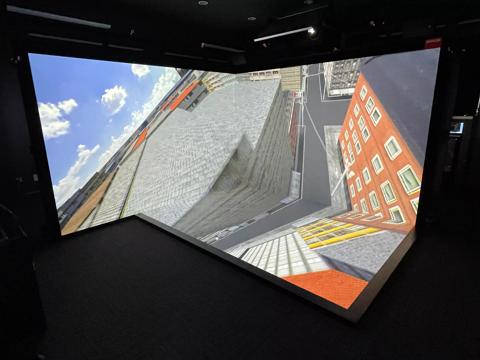I’m very happy with the implementation of Barco CAVE and extremely excited to encourage our team to use this facility to bring a visual experience closer to the real world.
Aichi Shukutoku University adopts Barco “CAVE” VR system for research on Sensibility Engineering Class
Nagakute, Aichi, Japan · 2023
Aichi Shukutoku University is a comprehensive university that actively practices learning in the local community and around the world. Based on the philosophy of "living together with differences", the university aim to cultivate excellent human resources who can develop their individuality while acknowledging each other's differences.
Within the Department of Human Informatics Kansei Engineering Major, the course focus on emphasizing sensibility, learning about design ideas, and manufacturing that are close to people, and developing human resources who can create human-friendly systems, software, information services and products, as well as space design that incorporate universal design.
Barco Solutions:
- 3x F80-Q7
Key Benefits:
- Multiple people can be immersed at the same time.
- Eliminate the possibility of accidents happening in the experiment due to the obstruction of the field of view with head-mounted glasses.
- The quality of VR image is closer to reality.
Context
Professor Hiroko Mori from the University’s Faculty of Human Informatics says that the Major’s goal of Sensibility Engineering Course is to develop and produce the STEAM ability in human resources required for realizing a sustainable society.
The fields that the major want them to master and play a part in the future are:
- building effective information services from the perspective of human sensibility and universal design, or utilizing them in product and space design;
- AI and big data - there are areas such as further evolution and deepening of technologies such as IoT and robot control, and
- human resources who support it toward a society where digital technology can be used appropriately.
Challenge
Professor Hiroko Mori continued, “Head-mounted display (HMD) devices have been introduced to my laboratory and allow users to experience a more space-saving and simple immersive sensation. But with HMD, there is the problem of being completely cut off from “surroundings”. However, in Sensibility Engineering, it is often the "surroundings" that contain important research elements, such as "scents" and "sounds" that are linked to sight, and sometimes "touching the skin" must be considered together. Simulations that are closer to real life are more practical in both education and research. To put it simply, it was essential for Sensibility Engineering to break away from the images within the virtual space in the 3D goggles and get closer to the "reality". In this aspect, HMD had its limitations.
There were several challenges that we want to overcome. For example, if you wear an HMD,
- You will not be able to operate a PC, carry something, or even execute the experiments while doing other work.
- Since multiple people can’t share common “virtual space” images simultaneously, the conversation is cut off and it’s not possible to immerse oneself in the space while walking. That said, they may no longer be virtual, but only "delusions". There was also the fear that it would lead to the accumulation of meaningless research because it is a "virtual space detached from the virtual reality".
- When the HMD obscures the eyes, the subject's "eye movements" are not visible from the outside. This means it’s impossible to observe whether the images in the goggles elicited a “realistic reaction” to the body movements. It was also not desirable in terms of ensuring the safety of the subjects during the experiment.
Solution
With these challenges in mind, Aichi Shukutoku University's Faculty of Human Informatics introduced Barco projection type VR system "CAVE" (3-screens) along with the establishment of a new course - Sensibility Engineering and started its operation in April 2023.
Professor Hiroko Mori talks about the merits of using "CAVE" in the research and education field of "Sensibility Engineering" and in what situations the CAVE is used for.
Compared to 3D goggles, the CAVE VR system provides a far more realistic sense of immersion. It is utilized in both the development and discharge of excellent human resources. She hopes that the CAVE VR system will break away from "just an experiment" in terms of universal design and bring a visual experience closer to the real world. This will lead to specific environmental improvement proposals for a society in which diverse people including people with disabilities can participate, not just in terms of age, gender, and race.
“We believe that it will lead to a future image that will be applied to the production-method and “what content should be” when turning picture books into VR content,” she said.
Results
Professor Hiroko Mori also shared about how they are utilizing CAVE and future research themes:
- In terms of "examination of universal design", consideration should be given to safety for the elderly, people with disabilities, color vision diversity, etc.
- Research on the type of space needed for the research to create a stress-free and comfortable environment, such as determining “the color that makes waiting time shorter”.
- In terms of "interactive content appreciation," research is focused on the viewer's impressions when viewing the work, and research on a space that can communicate with others while arousing the imagination.
- There is research on how the content should be created to elevate “simple reading” into an “enjoyable experience” by immersing oneself in the world of stories while stimulating the imagination as 3D digital picture books.
Talk to us
Don't hesitate to contact us with your questions. Our team will gladly point you in the right direction.




